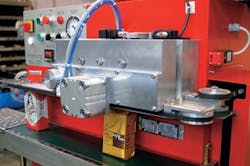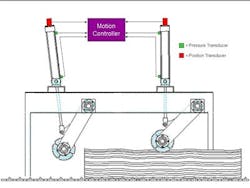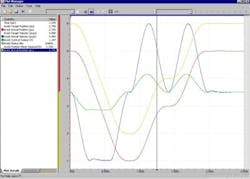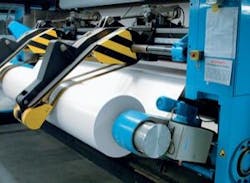Mike Bacidore is the editor in chief for Control Design magazine. He is an award-winning columnist, earning a Gold Regional Award and a Silver National Award from the American Society of Business Publication Editors. Email him at [email protected].
Despite an evolution of alternatives, pneumatics have stood the test of time. Hydraulic and electromechanical systems might offer a better solution in certain circumstances, but there are still plenty of pneumatic applications. We gathered input from a panel of industry veterans to determine how prevalent the technology still is and what to consider when making a decision.
Participants include TJ McDermott, project manager at Systems Interface, a systems integrator in Bothell, Washington; Chico Marks, manager of total plant maintenance, Subaru of Indiana Automotive in Lafayette, Indiana; Randy Nobles, regional vice president at Womack Machine Supply; Scott M. Maurer, product manager—air line at SMC; Frank Langro, director, marketing, product management, at Festo; Jerry Scherzinger, marketing pneumatics product manager at Bimba; Nathan Irvine, application and technical support, and Marchelle Forish, senior product specialist at Aventics, and Bill Savela, marketing director at Delta Computer Systems.
What do pneumatics have to offer that still make them a viable solution?
Nobles: Pneumatic systems are still easy to implement and maintain. Also, the operational speed for the amount of money invested is very attractive.
Bill Savela
Savela: Pneumatics can provide an optimal combination of force and compliance when controlled by a closed-loop motion controller with special capabilities for controlling both pressure/force and actuator position.
Scherzinger: Pneumatic devices are relatively low-cost and typically highly configurable, making them a great choice for both OEMs and MROs looking to provide a solution. Standard pneumatic actuators can, for example, be ordered in a wide variety of bore sizes, stroke lengths and mounting styles, making them highly flexible and capable of providing forces ranging from a few ounces—small bore sizes with low pressure—to over 10 tons—large bore sizes at 250 psi air pressure—in stroke lengths from fractions of an inch to 10 ft. Additionally, because pneumatics use air as the media, it is a clean source of work when compared to hydraulics, which uses hydraulic oil. A leak in a pneumatic system simply vents air to the atmosphere, but a leak in a hydraulic circuit discharges oil, requiring extensive cleanup and proper disposal.
Langro: Pneumatics can offer a variety of features that still makes it attractive to use. Pneumatics has few electrical connections and can be
Source: Festo
suitable in washdown areas. Also, the power density of pneumatics offers an advantage over electrics in applications such as stamping and pressing. When compared to a hydraulic solution, pneumatics can be a cleaner installation, which is clearly important to industries including pharmaceutical, food and beverage and semiconductor.
Also Read: Is Pneumatics Still a Good Solution?
What is your primary reason for choosing pneumatics?
McDermott: In the short term, a pneumatic solution usually costs less than an electric linear motor approach. The capital cost of linear motors typically far exceeds simple pneumatics. However, the longer a pneumatic system is in service, the higher the cost. Maintenance costs climb, and air leaks add to the cost. On the other hand, pneumatic systems are generally easier to troubleshoot. This is especially important when the knowledge pool in a maintenance department is decreasing due to attrition. A linear motor, likely involving a VFD and motion logic, needs maintenance staff skilled in motion control programming. We pick the solutions that fit the application. A pneumatic ram is a good choice for an on-deck hawser winch brake. It's relatively compact for the force exerted, and is easy to maintain and quite robust. For the remote actuator bank, running it via a common Fieldbus protocol such as Ethernet/IP or Profinet is the only way to go. Pulling many conductors for traditional central control is more costly than pulling a single Ethernet cable. The Fieldbus hardware is very reliable and using a device level ring gives redundancy for even more robustness.
Nobles: The primary reasons for using pneumatics are simplicity, compressed air availability and experience. We are seeing interest in conversion to electric actuators, but this trend hasn't been vast.
Savela: Pneumatics excels in applications that require the application of precise amounts of pressure or force, yet those that also benefit from the compliance of the air medium. Using electric motors in such applications would cost more and be more difficult to implement. In addition, holding a load in a pneumatic system can consume less energy, possibly zero, in a closed system, which isn't possible with an electric motor, unless an expensive braking scheme is implemented.
Frank Langro
Langro: The choice to use pneumatics, hydraulics, or electrics really should come down to the application requirements. What are you trying to move? How fast do you need to do it? What type of accuracy and repeatability is required? Are you planning to run multiple products that will require constant changeover? What are the environmental considerations? Based on these factors, you start to see which options offer the most viable solution. Pneumatics is a great choice for a case erector where the motion is highly repetitive and the motion requirements are not high precision. In contrast, a wafer inspection process in the semiconductor industry involves variable positions and requires high accuracies and repeatability, making an electrical-type motion solution more suitable for this application.
Can you talk about the types of machines or applications you're using pneumatics for?
Marks: We use pneumatics for the majority of our applications in the plant. They includes automated material handling, parts positioning for welding, paint application and bolt and fastener tightening. We do this with end-of-arm tooling on robots, dedicated clamping and positioning equipment, paint application bells and guns, and handheld fastener tightening torque guns.
Nobles: Womack is using pneumatics in several industries. We have applications on packaging, well service, food processing, and utility service equipment, to name a few.
Langro: Pneumatics are used in just about every industry that's involved in high- and even low-volume manufacturing. For example, diverse industries such as the automotive, semiconductor, pharmaceutical and food and beverage all have use for pneumatics in their various applications. Pneumatics can be found in the clamping and stamping of sheet metal parts in an automotive press shop, the lifting and transferring of wafers, and the coating of tablets in the pharmaceutical industry. Pneumatics is also found in gas box panels in the semiconductor industry. A common use of pneumatics is in the packaging of products. Pneumatics can be found in just about every machine that forms, fills or seals.
Jerry Scherzinger
Scherzinger: As a manufacturer, our components—actuators, valves, fittings, manifolds, FRLs—are used on a tremendously wide variety of machines designed for many applications. The applications range from agricultural equipment and transportation vehicles, which need to withstand harsh outdoor environments, to food processing and packaging equipment exposed to corrosive washdown chemicals and medical devices that require a high degree of precision. Common in-plant manufacturing applications include material handling equipment such as conveyor diverters and pick-and-place equipment.Savela: Fluid power applications in general benefit from the medium's ability to be used when pressure or force must be controlled in an application, and, within these application types, pneumatics excels when the application can benefit from a degree of compliance. Because air is much more compressible than hydraulic fluid, pneumatics can have an advantage in applications where force control is required, but which also need to have some give when an actuator and a work piece come together. Pneumatics are also especially useful in applications where the load can be subject to unknown shocks, bending applications where a force must be applied to the load to do the work, and force-backing applications where the load must have an accurate known force applied to it, such as a metal riveting application. Consider a press roll that is used to hold down lengths of logs as they are fed into a piece of sawmill equipment such as a planer, edger or bandmill. Controlling the press rolls means holding logs tightly without damaging them so as to not destroy valuable timber. Logs can be moving as fast as 2000 board ft/min, and the press rolls may need to sustain a force of up to 1,800 lb in order to maximize productivity. Adaptation of press roll positioning to maintain desired force without damaging the logs, even as log surface profiles are rapidly changing, can be accomplished better using pneumatics than other technologies.Chico Marks
Marks: Pneumatics are cheaper and simpler than linear motor packages from both an engineering and maintenance perspective. From an engineering view, PLC-controlled pneumatics are typically easier to design than a motor, requiring less PLC code, simpler position sensing, less complicated motion control, and less costly components. Maintenance enjoys many of the same benefits. Spare parts are both less expensive and simpler to install; they are typically plug-and-play, requiring minimal training and no parameter setup. However, these advantages come with a tradeoff. These simpler pneumatic systems are not as precise in their positioning or motion control as an electromechanical system. While it is true that a pneumatic system can be designed to be very precise, this would eliminate many of the benefits of using pneumatics.Savela: Pneumatics can handle high-cycle force applications that would degrade electromechanical solutions in a short period of time. An electromechanical solution may be more appropriate for applications which require speeds greater than about 40in./sec or accuracies better than 0.005 in., but most electromechanical solutions will not be able to match the life of a pneumatic solution in a force control application. In general, although they're typically fine for applications that do position control, linear electric motors aren't good for controlling force. Coupled with a proportional valve and precise transducers, a closed-loop motion controller can attain the same level of positioning accuracy as a linear motor, while also controlling pressure/force to a high degree of accuracy. Assuming that the pump, valve and control system can be mounted away from the actuator, but not too far away, a pneumatic solution can have a very small footprint at the actuator site and can place less weight on the moving actuator than a motor would. In applications that must apply and hold a given amount of force on an object, pneumatic systems have the advantage of being able to do so with lower energy consumption than electric motors, even linear ones. From the perspective of ease of use, a pneumatic system incorporating a motion controller with special support for fluid power control can be very easy to set up. For example, Delta Computer Systems' motion controllers are supported by RMCTools, a programming package that employs graphical tools to simplify system development and tuning. An example of one of Delta’s tools is the Plot Manager, which allows the designer to view the actual motion profile versus the target profile, so that errors can be removed via fine tuning. The screen capture below shows a plot made with the Plot Manager.Source: Festo
machine are the actuators? Ideally the valve bank will be fairly close to the actuators. This can be accomplished with a decentralized approach. Some valve systems allow adding branches from the main manifold for placing additional valves in remote parts of the machine, much closer to the cylinders at the point of actuation. A valve manifold system can also allow you to bring your I/O back to the valve manifold and enable you to utilize it as your main control device for the machine or cell.Nobles: The main consideration is the type of communication the customer has in its installed base of equipment. If there are no other bus communications present, then the choice is made based on our supplier's preferred communication protocol.Savela: For precise operation, closed-loop motion controllers need to work through zero-deadband servo-quality proportional valves that respond quickly to control inputs. And the valve should be placed as close as possible to the pneumatic cylinder.Pneumatics can be used to power certain simple linear motion requirements, but are there air supply and maintenance hassles that come with pneumatics?Savela: Not if system-level design issues are considered when the design is done. For example, to avoid problems of not having enough supply pressure at times when motion is rapid, an appropriately sized accumulator should be used. And to avoid maintenance problems and control energy costs, the pump should be sized to meet the average system load. Most industrial/factory environments have pneumatic lines plumbed to most locations in the plant. There is typically minimal effort required to supply the air to the actuator.Nobles: The hassles that go along with pneumatic systems are no more egregious than any other technology. Proper maintenance and education help the life of pneumatics and other systems.Langro: All installations, be they pneumatic, hydraulic or electric, have their specific maintenance requirements. The maintenance of a pneumatic system is really fairly simple and involves ensuring that the air quality and operating pressure are properly maintained. There are visual indicators on the filter units that show when the filter element needs to be changed. Many suppliers can offer automatic drain systems as well, to avoid an overflow of water accumulating in the filter bowl. Differential pressure sensors can be integrated into the air prep system and can automatically send a signal to your PLC indicating a need for maintenance. This type of new advancement can simplify the maintenance aspects of a pneumatic system.
Scott Maurer
Maurer: Like other plant utilities, compressed air requires conditioning and maintenance to avoid problems with the valves, cylinders and other tools that use it. Cooling water systems require various chemical treatments, as well as filtration to avoid fouling issues. Electrical systems benefit from power and signal conditioning to assure clean, consistent power and noise-free communication. Condensed water, compressor oils and particulates are the major culprits in a compressed air system, but they can be addressed easily with supply side and supplemental point-of-use methods. A properly selected drying and filtration system, along with a solid PM program, can minimize operational issues.
McDermott: The single biggest hassle in a pneumatic system is eliminating leaks. Leaks cost an incredible amount of money, but in every facility I visit you can hear the hiss of at least one leak. To be honest, I don't understand why this is so; eliminating leaks is easy and the simplest way to decrease operating costs.
Does the availability of high-pressure compressed air have an impact on whether to use a pneumatic solution because the lack of pressurized air or gas would necessitate installing compressors, tubing and valves?
Maurer: Certainly, the existence of a compressed air system impacts whether a user elects a pneumatic solution. For a plant without a compressed air system, there is the obvious cost/benefit analysis of adding another utility. Are there other processes that will be added that can utilize any excess system capacity to be installed, or is a right-sized solution for a single process more appropriate? Any installation of pneumatically operated equipment should include an evaluation of the system's supply capabilities. If you are adding demand to an existing system, will the additional consumption exceed its capabilities? Unlike tripping a breaker on an overloaded electrical circuit, an overloaded pneumatic system starves part or all of the system when confronted with excessive demand. So whether you are evaluating adding that first piece of pneumatic equipment to a plant or the hundredth, you need to consider the costs associated with the required compressor capacity.
McDermott: When a plant already has compressed air available, then pneumatic solutions should be considered. If the facility doesn't already have compressed air, the application must be so biased toward pneumatics as to be obvious to anyone that it must be that way.
Langro: Most industrial facilities are using compressed air for tools, such as screwdrivers, wrenches and other devices. This definitely makes the decision to use pneumatics feasible because the facility already has an infrastructure in place for a pneumatic system.
Nobles: If compressed air isn't present, it does affect the overall economic picture for an installation. When a compressor is needed, an electromechanical system can be more attractive.
How do operating conditions such as contaminated, explosive, wet or corrosive environments affect the choice between pneumatic and electromechanical solutions?
Nobles: The proper choice of components based on environmental conditions is essential for the long life of both pneumatic and electromechanical systems. Certain applications in explosive environments can be implemented with significantly less cost using a pneumatic system.
Marks: Our paint application process almost entirely uses pneumatic applicators. This approach provides quality control and hazard-avoidance benefits in terms of safety implications. The applicators are located inside of a paint booth, an explosive environment in which an electrical spark could cause ignition. Every effort must therefore be made to keep electrical components outside of the booth.
Delta Computer Systems Plot Manager Feature of RMCTools
Delta Computer Systems RMC Tools Software
Festo DGC-K Compact Rodless Pneumatic Drive
Festo MS6-E2M Module
Bimba Manufacturing SPCS-2
Bimba Manufacturing IntelliSense
Aventics Pneumatic Directional Control Valve Manifold System
What sorts of safety concerns do pneumatics create or alleviate?
McDermott: Pneumatics can enhance safety when the application is in a hazardous environment where electrical actuators or motors are prohibited. The electrically activated valves are placed in a nonhazardous area, and the pneumatic lines lead to the actuators in the hazardous environment.
Marks: One of the safety concerns associated with pneumatics is control of stored energy. This comes into play during associate parts loading at point of operation as well as in lockout/tagout maintenance repair operations. The stored energy has the potential to release at unintended times and make contact with personnel, introducing the potential for personal injury. However, pneumatics does eliminate the explosion potential that would be present using electrical applications in our paint operations.
Nobles: Pneumatics is no more or no less a safety concern than other technologies. Proper maintenance and education help prevent problems with pneumatic systems.
About the Author
Mike Bacidore
Editor in Chief
Mike Bacidore is chief editor of Control Design and has been an integral part of the Endeavor Business Media editorial team since 2007. Previously, he was editorial director at Hughes Communications and a portfolio manager of the human resources and labor law areas at Wolters Kluwer. Bacidore holds a BA from the University of Illinois and an MBA from Lake Forest Graduate School of Management. He is an award-winning columnist, earning multiple regional and national awards from the American Society of Business Publication Editors. He may be reached at [email protected]
Leaders relevant to this article:


